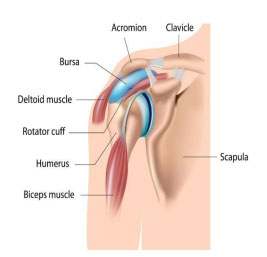Our daily lives are full of repetitive motions such as painting, lifting various objects, and sleeping on our sides. Certain sports also involve repetitive motions, especially sports that involve throwing like softball, baseball, and football. As a result of these kinds of activities, we may have trouble elevating our arms above our heads. The cause may be a torn rotator cuff.
Read the information below to learn more about this condition.
Two Types of Rotator Cuff Tears
● There are two types of rotator cuff tears: partial and complete.
● Partial tears are incomplete tears that do not completely detach from the bone.
o The best treatment for a partial tear is rest and physical therapy.
● Complete tears (complete full thickness tears) go completely through the tendon.
o Surgery is recommended for this type of tear.
Causes
● Rotator cuff tears can be caused by extending the arm outward as you fall, trying to lift heavy objects (weights) overhead (power cleans, shoulder snatches, kettlebell swings, etc.).
o A chronic tear occurs overtime.
o The chronic tears begin as tendonitis or a shoulder impingement. Overtime, the tendons wear down and tear.
Symptoms
● Intense pain after a sudden fall
● Shoulder weakness on the affected side
● Difficulty moving the affected shoulder
● A popping or crunching sound during movement
Treatment
● Contact your primary care physician for a shoulder X-ray to assess the bone structure and an MRI/CT to assess soft tissue, tendons, fluid buildup (bursitis), and tears.
● The best treatment plan for rotator cuff tears is to reduce the pain and restore the affected shoulder function.
● Rotator cuff tears are treatable with rest, ice packs and heating pads for 20 minutes four times per day interchangeably, and physical therapy.
● NSAIDS (Advil, Aleve, Naproxen, ibuprofen, etc.) are effective for managing the pain and swelling.
● Steroid shoulder injections may be effective.
● Depending on the results and the level of pain, a referral to an orthopedic surgeon may be necessary.


References
Alila Medical Media. (2019). Shoulder bursa, bursitis. [Illustration]. https://www.shutterstock.com/image-illustration/shoulder-bursa-bursitis-122298685?src=LgujqAxYpFEk2V8pW5kcBw-1-8
Alila Medical Media. (2020). Rotator Cuff Anatomy, Labeled. [Illustration]. https://www.shutterstock.com/image-illustration/rotator-cuff-anatomy-labeled-147943874.
Hospital for Special Surgery. (2019). Rotator Cuff Tears, Injuries and Treatments. Retrieved from https://www.hss.edu/condition-list_rotator-cuff-injuries.asp#treatment-torn
